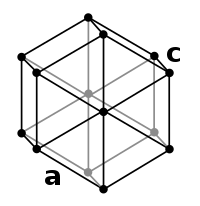
Photo from wikipedia
Using nonthermal plasma (NTP) to promote CO2 hydrogenation is one of the most promising approaches that overcome the limitations of conventional thermal catalysis. However, the catalytic surface reaction dynamics of… Click to show full abstract
Using nonthermal plasma (NTP) to promote CO2 hydrogenation is one of the most promising approaches that overcome the limitations of conventional thermal catalysis. However, the catalytic surface reaction dynamics of NTP-activated species are still under debate. The NTP-activated CO2 hydrogenation was investigated in Pd2Ga/SiO2 alloy catalysts and compared to thermal conditions. Although both thermal and NTP conditions showed close to 100% CO selectivity, it is worth emphasizing that when activated by NTP, CO2 conversion not only improves more than 2-fold under thermal conditions but also breaks the thermodynamic equilibrium limitation. Mechanistic insights into NTP-activated species and alloy catalyst surface were investigated by using in situ transmission infrared spectroscopy, where catalyst surface species were identified during NTP irradiation. Moreover, in in situ X-ray absorption fine-structure analysis under reaction conditions, the catalyst under NTP conditions not only did not undergo restructuring affecting CO2 hydrogenation but also could clearly rule out catalyst activation by heating. In situ characterizations of the catalysts during CO2 hydrogenation depict that vibrationally excited CO2 significantly enhances the catalytic reaction. The agreement of approaches combining experimental studies and density functional theory (DFT) calculations substantiates that vibrationally excited CO2 reacts directly with hydrogen adsorbed on Pd sites while accelerating formate formation due to neighboring Ga sites. Moreover, DFT analysis deduces the key reaction pathway that the decomposition of monodentate formate is promoted by plasma-activated hydrogen species. This work enables the high designability of CO2 hydrogenation catalysts toward value-added chemicals based on the electrification of chemical processes via NTP.
Journal Title: Journal of the American Chemical Society
Year Published: 2022
Link to full text (if available)
Share on Social Media: Sign Up to like & get
recommendations!